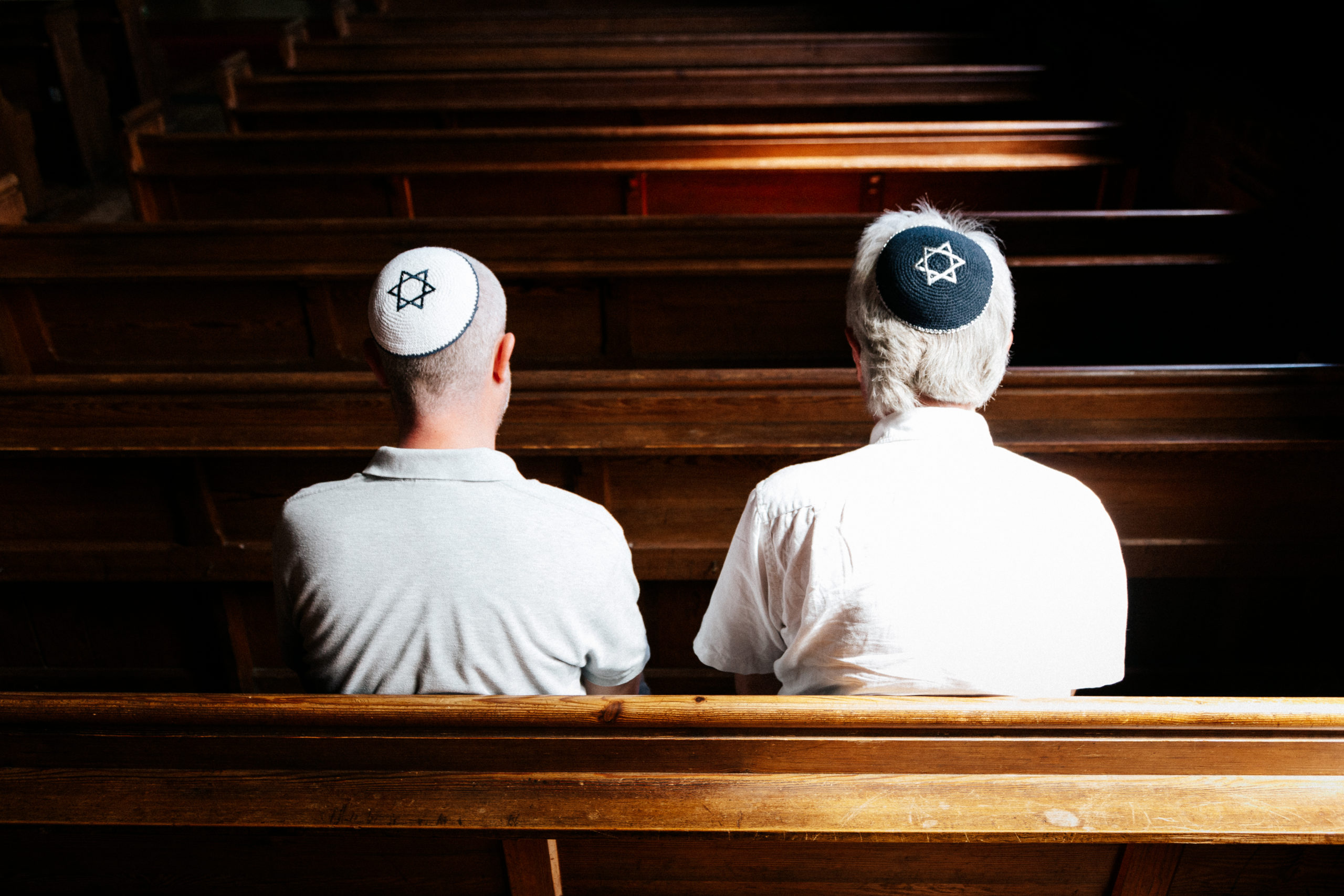The managerial class wants to replace America’s core demographic with one it can more easily control.
“Whiteness” is an Antisemitic Trope

First the Jews became whites; then the whites became Jews.
The call to “abolish whiteness” may have started as an academic conceit some 30 or 40 years ago, but it has since moved into the mainstream. “Whiteness” in this sense describes a constructed category that necessarily implies genetic superiority and demands apartness. It is responsible for the racialization of America and for the disparate outcomes that are a defining feature of American socio-economic life.
Beneficiaries of whiteness—“people who think they are white” in the words of Ta-Nehisi Coates—reap unearned privileges. The abolition of whiteness, according to its proponents, will entail the dismantling of American society in order to reconstruct it in a manner that will no longer benefit people who think they are white, who must simultaneously be disabused of the illusion that they are racially constituted as better than anyone else.
In theory, “abolishing whiteness” doesn’t imply violence against individual people. In practice, however, the historical abolition of classes of people has generally suffered a kind of mission creep in the direction of actual extermination, especially when specimens of the target class resist comprehending the essential justice of their dispossession.
As the Guinean Marxist revolutionary theorist Amílcar Cabral explained, “in order to truly fulfill the role in the national liberation struggle, the revolutionary petty bourgeoisie must be capable of committing suicide as a class in order to be reborn as revolutionary workers.” But “this alternative—to betray the revolution or to commit suicide as a class—constitutes the dilemma of the petty bourgeoisie in the general framework of the national liberation struggle.”
Indeed, the choice either to “commit suicide as a class” or to be a traitor to the revolution is a difficult “dilemma” that has cost the lives of tens of millions of truculent kulaks across the world.
But the “abolition of whiteness” is actually closer to the much longer history of counter-Judaizing efforts that have characterized the last 2500 years of global Jewish dispersal. In the rhetoric around whiteness and its inherent violence and exploitation; its magical ability to infect all conditions and practices; the essential blood guilt that pertains to all whites by virtue of birth regardless of circumstances; the unfair economic systems that whites have created to suck wealth and labor from nonwhites; and the dire necessity to erase the taint of whiteness from humanity, “whiteness abolition” resembles closely, and indeed is built upon the formulas of classical antisemitism. It is fair to say that whites—at least in regard to the open, unembarrassed scorn and calumny that is thrown against them—have become the new Jews.
For Their Own Good
Abolishing whiteness is usually cast as a form of liberation for everyone, especially whites, who are to be freed from the self-imposed burden of mastery over the lesser races. Noel Ignatiev, the leading theorist of white abolition, announced that “treason to whiteness is loyalty to humanity.” This sense of stepping down from a deluded majesty and pledging allegiance to the masses also defines the long history of counter-Judaism polemic. As Marx wrote in “On the Jewish Question:”
For us, the question of the Jew’s capacity for emancipation becomes the question: What particular social element has to be overcome in order to abolish Judaism?…. Emancipation from huckstering and money, consequently from practical, real Judaism, would be the self-emancipation of our time.
An organization of society which would abolish the preconditions for huckstering, and therefore the possibility of huckstering, would make the Jew impossible…. In the final analysis, the emancipation of the Jews is the emancipation of mankind from Judaism.
The crusade to “liberate” Jews/whites from their destructive identity is never described as a reaction to oppression, which would imply vengeance and blood guilt. It is always cast as a transcendent road to freedom for everyone. As Martin Luther explained in On the Jews and Their Lies, the eradication of Jews must be carried out without rancor or ill will, as an act of tender mercy:
With prayer and the fear of God we must practice a sharp mercy to see whether we might save at least a few from the glowing flames. We dare not avenge ourselves. Vengeance a thousand times worse than we could wish them already has them by the throat. I shall give you my sincere advice:
First, to set fire to their synagogues or schools and to bury and cover with dirt whatever will not burn, so that no man will ever again see a stone or cinder of them….
Similarly, Ibram X. Kendi remarks that “racism is harming white people and they don’t notice it.” Racism, a symptom of whiteness as tumors are a symptom of cancer, is mistaken as the basal condition of a healthy white society by sick people who can’t imagine life without their cherished disease. Antiracism, according to White Fragility author Robin DiAngelo, is the painful process of awakening white people to their sickness so they can begin the long process of healing. “As long as whiteness remains unnamed it will continue to reproduce racial inequality,” explains DiAngelo, much as Jewish rocks, unburnt and unburied, would continue to infect pious sixteenth-century German Christians.
Escaping Whiteness
The transition of the population of the United States to “majority-minority” status is a frequently cited feature of American demography that is generally discussed as a natural, inevitable process—like the subduction of tectonic plates or the eventual fading of the sun. While the change is cast as inexorable, the relative decline of the white population is also celebrated as an opportunity for the country to throw off the shackles of racial dominance and embrace a new future, which may be multiracial or post-racial, but will definitely be less white.
A popular version of the history of racial assimilation in America is the idea that foreign elements are gradually admitted to the “whiteness” that characterized the English settlers of the early seventeenth century and which was established as the norm, against the “blackness” that was assigned to Africans to justify their inheritable status as slaves. According to this narrative, first German, and then Irish immigrants were permitted to enter the country but were not initially accepted as white people with all the attendant privileges. These groups gradually assimilated and attained full whiteness. Following these Northern European immigrant groups, Italians and Jews—who were originally “not white”—gradually became white, too.
Other groups, the narrative goes on, will also become white and acquire the social advantages attached to this racial status. Asians are now sometimes considered to be “white adjacent,” and we see how they are typically excluded in discussions of the difficulties that face “black and brown” people, or “people of color,” in terms of economic hardship, academic success, and higher rates of imprisonment. Though professional Asian and Latino Americans may cling to their identity as nonwhite for reasons of political cohesion and personal economic advancement, working- and middle-class nonwhites seem increasingly to find the whole calculus perplexing, unprofitable, and boring. Like most normal people they want to live in safe neighborhoods, send their children to good schools, and own the biggest houses and cars they can afford.
This assimilationist narrative has broken down, however, by the introduction of legal schemes of preferential racial treatment. Instead of people aspiring to partake of whiteness—as the Irish and Italians may have done a century and more ago—we see instead what Steve Sailer has called “the flight from white.” What is the actual advantage of being perceived as white in professional society anymore? There used to be a literature of “racial passing” in American letters, as depicted in the works of Charles Chesnutt and Nella Larsen, where light-skinned blacks “passed” as whites. But no intelligent light-skinned black person would pass up the opportunity to be regarded as black in present American society. In fact, as the case of Rachel Dolezal vividly demonstrates, advantages flow in the opposite direction.
Thus we see a broad effort on the part of some whites to disparage their own connection to loathed whiteness. The number of people claiming Native American descent, for example, grew by 87% between 2010 and 2020—a figure that cannot be explained by a surging birth rate or immigration. The Biden administration promised to expand the Census to include “invisible” groups, such as people from the Middle East and North Africa—who must count themselves as white in existing categories—and the LGBTQ.
That the flight from white would include people who consider themselves “queer,” a catch-all designation for people whose sexual identity is so refined that “bisexual” doesn’t cover it, is an indicator of how desperate many whites are to jump ship. Many Ashkenazi Jews, of European descent, are also eager to opt out of whiteness. Liberal Jews frequently draw attention to the history of suffering they share with black Americans, and point out how intensely Jews worked to help blacks earn their civil rights. From Julius Rosenwald to Samuel Leibowitz to Michael Schwerner and Andrew Goodman to Abraham Joshua Heschel, there is without doubt a long history of Jews who fought for black rights. At the same time, many Jews—while acknowledging their participation in whiteness and its privileges—seem keen to put themselves in the “Other” category along with the LGBTQ, Lebanese, and Persian communities. Comedian Sarah Silverman and biologist Bret Weinstein are among Jews who have recently demanded a qualification of their whiteness, as did a recent letter-writer to the New York Times’s “Ethicist” column: “I’m Jewish and Don’t Identify as White. Why Must I Check That Box?”
The problem for Jews is that, in the eyes of the people who matter, they aren’t just identified as white, they exemplify whiteness. Jews are not the ones who get to say that they are or aren’t white, any more than white people get to declare that they aren’t racist. It’s like a defendant in a rape trial insisting he’s innocent—well, you would say that, wouldn’t you? Jews often argue that if they were really white, then Hitler wouldn’t have persecuted them. But as Whoopi Goldberg recently argued, the Holocaust was “white-on-white fighting.” The principle that “black lives matter” does not carve out an exception for Jews. As the richest, best-educated, most connected and high-profile group of whites in America, Jews will have as much luck in convincing tomorrow’s racial commissars of their nonwhite status as Tagg Romney, Mitt’s eldest son…or maybe even less, since Tagg’s grandpa George was born in a Mormon colony in Mexico.
It is certainly true that the Jews at one time were not considered fully white in America—though that didn’t stop Judah Benjamin from essentially running the Confederate States of America, perhaps as the last of the great “court Jews.” But nowadays Jews are—at least in the eyes of the Left—full participants in whiteness, and as such they bear the same mark of Cain as their palefaced brethren. Antisemitism has come full circle in America. First the Jews became white; and then the whites became Jews.
The American Mind presents a range of perspectives. Views are writers’ own and do not necessarily represent those of The Claremont Institute.
The American Mind is a publication of the Claremont Institute, a non-profit 501(c)(3) organization, dedicated to restoring the principles of the American Founding to their rightful, preeminent authority in our national life. Interested in supporting our work? Gifts to the Claremont Institute are tax-deductible.
As “whiteness” becomes code for “evil,” many Jews are understandably—but misguidedly—fleeing the label.
America can incorporate newcomers, but only if they become Americans.
America’s managerial elites are seeking demographic transformation by any means necessary.




